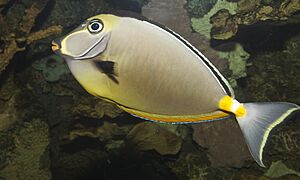Clown unicornfish facts for kids
Quick facts for kids Clown unicornfish |
|
|---|---|
 |
|
| Conservation status | |
| Scientific classification | |
| Synonyms | |
|
The clown unicornfish, also known as Naso lituratus, is a cool marine fish. It's part of the Acanthuridae family, which includes surgeonfishes and tangs. You can find this fish swimming in the eastern Indian Ocean and the western Pacific Ocean.
This fish is easy to spot because of its unique look. It has two bright orange spines that point forward on its tail base. Its lips are orange, and it has a black mask-like pattern on its face. The body is brownish-grey with a yellow area on its neck, and its top fin has a wide black band. Clown unicornfish can grow up to about 45 centimeters (18 inches) long.
A special thing about these fish is that they have tiny bacteria called Epulopiscium living inside them. These bacteria are super helpful! They assist the clown unicornfish in digesting the algae that make up a big part of their diet.
Contents
What is a Clown Unicornfish?
The clown unicornfish, or Naso lituratus, is a type of fish that lives in the ocean. It gets its name partly from the "unicornfish" group. These fish are known for their unique features, like the horn-like bumps some species have on their foreheads. The clown unicornfish doesn't have a horn, but it has other cool features.
How Do Scientists Name Fish?
Scientists use a system called Taxonomy to name and group living things. This helps everyone around the world know exactly which animal they are talking about. The clown unicornfish was first officially described in 1801. A German scientist named Johann Reinhold Forster gave it the name Acanthurus lituratus back then. Later, it was moved into the Naso group, which is the only group in its special subfamily called Nasinae.
Clown Unicornfish Features and Habits
The clown unicornfish has some distinct features that make it stand out. Its bright orange lips and the black mask on its face are very noticeable. It also has a single fin on its back with a broad black band.
Body and Fins
This fish has several fins that help it swim and balance. It has a long fin on its belly with two spines and many soft rays. The fin on its back also has spines and soft rays. Its pectoral fins (on the sides) and pelvic fins (on the bottom) are paired. The tail fin is shaped like a crescent moon.
Special Tail Spines
One of the most interesting features is on its tail base, called the caudal peduncle. Here, it has two sharp, forward-pointing blades. These blades are like built-in defense tools! When a predator comes too close, the clown unicornfish can extend these strong tail spines to protect itself. Young clown unicornfish have blades that are not fully grown yet.
What They Eat
Clown unicornfish are herbivores, meaning they mostly eat plants. They love to munch on wild algae found on coral reefs. The special Epulopiscium bacteria in their gut help them break down this algae, making it easier to digest.
Where Clown Unicornfish Live
Clown unicornfish live in the warm waters of the eastern Indian Ocean and the western Pacific Ocean. They prefer to live in coral reefs. You can often spot them swimming around the reefs, sometimes in pairs.
Their Environment
These fish need certain conditions to thrive. They like areas with high oxygen levels and strong water currents. They also need plenty of algae to feed on.
Family Life
Clown unicornfish reproduce throughout the year in places like Guam. The male and female fish are separate and can have different sizes.
Clown Unicornfish and Humans
Clown unicornfish are important to humans in a couple of ways. Sometimes, they are caught and used as a food source. They are also popular in the pet trade and are kept in aquariums because of their beautiful colors and unique appearance.


